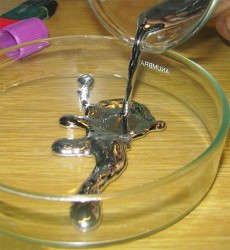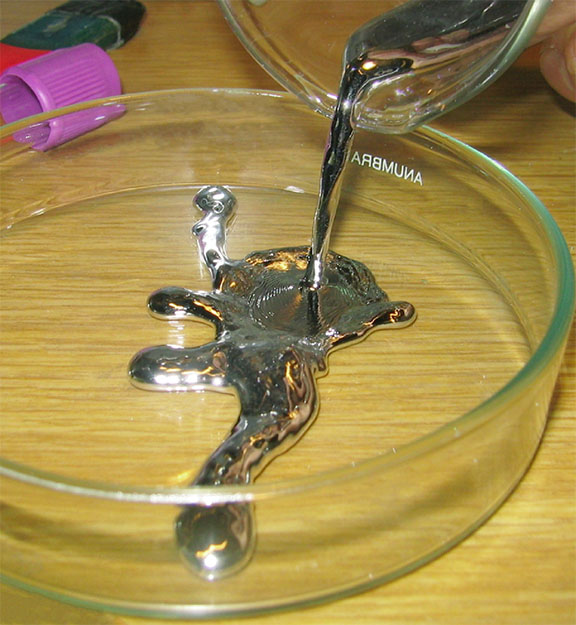Guyana has embarked on a process to ease the importation and use of mercury as an endorsement of the Minamata Convention on Mercury, the United Nations Environment Programme (UNEP) on October 10, 2013.
In the light of this the Guyana Gold and Diamond Miners Association (GGDMA) seeks to enlighten the general public and users of mercury, particularly miners, on strategies for mercury-free solutions and techniques which can be employed to reduce mercury use and its effects on the human and physical environments.
The focus of this first article is on an introduction to the subject
What is Mercury?
 Mercury is a naturally occurring element represented by the symbol Hg on the periodic table usually found in air, water and soil. It exists in several forms: elemental or metallic mercury (pure mercury), inorganic mercury compounds (Cinnabar) and organic mercury compounds (methyl mercury).It is commonly known as quicksilver and was formerly named hydrargyrum (from Greek “hydr-” water and “argyros’’ silver).
Mercury is a naturally occurring element represented by the symbol Hg on the periodic table usually found in air, water and soil. It exists in several forms: elemental or metallic mercury (pure mercury), inorganic mercury compounds (Cinnabar) and organic mercury compounds (methyl mercury).It is commonly known as quicksilver and was formerly named hydrargyrum (from Greek “hydr-” water and “argyros’’ silver).
History of Mercury
Mines in Almadén (Spain), Monte Amiata (Italy), and Idrija (now Slovenia) dominated mercury production from the opening of the mine in Almadén 2500 years ago, until new deposits were found at the end of the 19th century. In China and Tibet, mercury use was thought to prolong life, heal fractures, and maintain generally good health, although it is now known that exposure to mercury leads to serious adverse health effects.
The ancient Greeks used mercury in ointments; the ancient Egyptians and the Romans used it in cosmetics which sometimes deformed the face. By 500 BC mercury was used to make amalgams (Medieval Latin amalgama, “alloy of mercury”) with other metals.
Occurrence of Mercury
Mercury is an extremely rare element in the Earth’s crust. It occurs in deposits throughout the world usually in very young orogenic belts where rock of high density are forced to the crust of the Earth, often in hot springs or other volcanic regions mostly as cinnabar (mercuric sulfide).
Apparatus for the distillation of cinnabar, Alchimia, 1570, Chemical Heritage Foundation
Cinnabar is a vein-filling mineral associated with recent volcanic activity and alkaline hot springs. Cinnabar can be found in the Philippines, Spain, California, Slovenia, Egypt, Texas, and the province of Guizhou in China. To produce liquid mercury (quicksilver), crushed cinnabar ore is roasted in rotary furnaces. Pure mercury separates from sulfur in this process and easily evaporates. A condensing column is used to collect the liquid metal, which is most often shipped in iron flasks. Cinnabar has been mined since the Neolithic Age and it has been the main source of mercury throughout the centuries.
Properties of mercury
Physical properties
As a heavy, silvery element, mercury is the only metal that is liquid at standard conditions for temperature and pressure with a freezing point of −38.83 °C and boiling point of 356.73 °C.As compared to other metals, it is a poor conductor of heat, but a fair conductor of electricity.
Chemical properties
Mercury does not react with most acids. Like silver, mercury reacts with atmospheric hydrogen sulfide. It even reacts with solid sulfur flakes, which are used in mercury spill kits to absorb mercury vapors.
Amalgams
Mercury alloys easily with many metals, such as gold, silver, and tin. These alloys are called amalgams. Iron is an exception and iron flasks have been traditionally used as containers to trade mercury.
Applications
As a metal, mercury has a variety of uses ranging from medical to scientific. Such uses include thermometers, barometers, manometers, sphygmomanometers, float valves, mercury switches, mercury relays, fluorescent lamps and other. It remains in use in scientific research applications and in amalgam material for dental restoration in some locations.
Historically and to present day mercury is used extensively in alluvial gold mining operations in order to help the gold capture gold grains. Other historic application of mercury includes; traditional medicine as a diuretic, topical disinfectant, and laxative.
However as a result of mercury effects on occupational health and the environment 140 countries agreed in the Minamata Convention on Mercury by the United Nations Environment Program (UNEP) to prevent emissions. Thus due to the effects of mercury exposure, industrial and commercial uses are regulated in many countries (United States, Norway, Sweden and Denmark). Further, the World Health Organization (WHO), Occupational Safety and Health Association (OSHA), and National Institution for Occupational Safety And health (NIOSH) all treat mercury as an occupational hazard, and have established specific occupational exposure limits.
The regulatory bodies responsible for the management of mercury in Guyana are; Guyana Geology and Mines Commission (GGMC), Environmental Protection Agency (EPA), The Pesticide and Toxic Chemical Control Board and the Ministry of Health (MOH).he Mining Act, Mining Regulations, Mercury Code of Practice, and The Environment Protection Act of 1996 were developed to monitor and regulate the use of mercury within the mining industry; in addition studies were conducted by Guyana Environmental Capacity Development (GENCAPD) Mining Project, the Institute of Applied Science and Technologies (IAST) and World Wildlife Fund (WWF) to assess the potential effects of mercury on the environment and occupational health.
In the next article we will discuss the use of mercury by local miners and summarize the results of several studies done locally on mercury and its effects.





